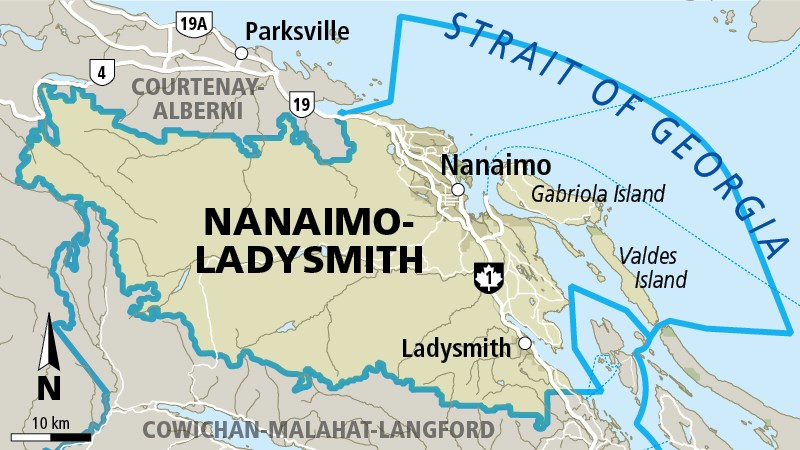Be honest: Four years ago, could you have envisioned the Conservatives on the same side of the law as an industrial-scale marijuana grow-op?
But weird as it seems, that’s the situation in Nanaimo, where medical-marijuana producer Tilray finds itself on the establishment side of the pot debate.
With $3.2 million in annual payroll, Tilray became one of the bigger employers in town when it opened in 2014. This spring, it announced plans to quadruple the size of its 65,000-square-foot Duke Point production facility, adding 275 jobs.
Then came June and word that the company was laying off 61 people. The plant now employs 130. Company vice-president Philippe Lucas, the former Victoria city councillor, says Tilray still plans to expand — just not right now.
The reason for the setback — or at least one example of it — can be found in the heart of Nanaimo. Right near the intersection of Church and Chapel sits Island Releaf, a bright and airy pot shop that, having just opened in August, still has that new-car smell.
“There’s probably nine other dispensaries in town,” says owner Sheina Criss, standing behind a display of marijuana salves and capsules. Vancouver has another 100 shops, Victoria close to 20. And they’re all taking market share.
Tilray operates within Health Canada rules that say medical-marijuana users may buy only from large-scale licensed producers that ship their product by mail. Alas for Tilray and Canada’s two dozen other licensed growers, perceived foot-dragging by Ottawa after a series of court defeats — it was ruled the feds weren’t doing enough to make medical marijuana available — created a legal void filled in the past year by cheaper, buy-your-pot-on-the-spot shops operating outside the Health Canada system.
This is particularly true on the West Coast where, with recreational marijuana use now legal in Alaska, Washington and Oregon, the prevailing opinion seems to be that Ottawa is out of step, pot prohibition has been a failure, so we might as well accept reality and get on with regulation instead — except what we have right now looks more like the Wild West.
Not that pot laws are anywhere near the top of the list of election issues here.
In fact, the diversity of the place makes it impossible to seize one issue and say: “This, this is what matters to Nanaimo.” Too many different people living too many realities for that.
Tilray’s presence is an indicator of that diversity, a reminder that the resource sector doesn’t define Nanaimo’s character as it once did. It’s a place of California retirees, university boffins (including Thomas Mulcair’s sister), truck loggers, health workers, marine scientists (whose tongues were surgically removed by the prime minister’s office), many, many shopping malls and a historic downtown whose bookstored-and-caféd main drag took first place in a national Great Streets contest. Nanaimo is hard to pigeon-hole.
With a population of 84,000, it has passed the city of Victoria to become the second-largest municipality on Vancouver Island, behind Saanich. It also has most of the 115,000 people in the new riding of Nanaimo-Ladysmith.
“We’ve got businesses that you don’t even know about,” Mayor Bill McKay says. Take Seamor Marine, maker of remotely operated vehicles that poke around shipwrecks. Take all those companies based, like Tilray, in the Tonka Toys for Big Boys sprawl of the Duke Point industrial area.
Forestry is still a big dog, though. Hundreds of city residents have what McKay calls “lunchbucket” jobs that take them into the woods each day. Tilray backs onto the Harmac pulp mill property, where 340 work full time; the Little Success Story That Could keeps ticking along seven years after being saved from extinction by local investors, including its own employees. Island Timberlands is just past Harmac. Down the road, Western Forest Products has begun a $28-million upgrade of its sawmill.
But WFP also closed its downtown Nanaimo sawmill for good in December. The site dominates the view from one side of the new Nanaimo Port Authority offices, as though to reinforce the point that the industry isn’t what it once was.
“The Nanaimo Port Authority has been a forest products distribution centre for the past 50 years,” CEO Bernie Dumas says. The reality, though, is that it exported a quarter as much lumber in 2014 as in 1996.
Hence the port’s push for, again, diversity. It increased its flexibility in June with the arrival at Duke Point of a Brazilian-built crane capable of lifting 104-tonne loads and dropping them on giant post-Panamax ships. That’s a step up from the existing gantry crane and its 40-tonne capacity.
“We see ourselves as the freight gateway for Vancouver Island,” Dumas says. The authority wants to entice big outlets like Walmart and Costco to ship goods from Asia directly to Nanaimo, instead of unloading on the mainland and serving the Island by truck from distribution centres there. It also sees a future in the break-bulk sector — unloading, storing, then barging off industrial pieces too large to ship in containers, such as the tens of thousands of Asian-built components for B.C.’s planned LNG plants. (An example of this was when the Cape Scott Wind Farm’s 55 giant windmills arrived in their disassembled state — Ikea furniture for engineers.)
The port authority is also pushing short-sea shipping, using barges, not trucks, to move everything from lumber to Fanny Bay’s Natural Glacial Waters to the mainland. Meanwhile, Westwood Shipping has begun monthly service direct to Japan and Korea. The just-announced Trans Pacific Partnership could hold promise.
A new cruise ship terminal has modest goals, 20 to 25 ships a year; eight are on next year’s schedule.
Nanaimo’s diffuse character, the variety of perspectives among voters, makes election forecasting a bit of a mug’s game. Prior to redistribution, the city was split between two ridings, one represented by James Lunney, who ran as a Conservative, and the other by New Democrat Jean Crowder, neither of whom is running again.
Contesting the seat are former Islands Trust chairwoman Sheila Malcolmson for the NDP; real estate agent Tim Tessier for the Liberals; Jack East for the Marxist-Leninists; and filmmaker Paul Manly — the son of Jim Manly, who represented the riding as a New Democrat in the 1980s — for the Greens.
The selection of Conservative candidate Mark MacDonald surprised some; in 2013 he was managing editor of the Nanaimo Daily News during an uproar over the publication of letters to the editor deemed deeply hurtful by local aboriginals.
“They were very upset by the letters and subsequent statements that Mr. MacDonald made,” says city councillor Diane Brennan. But in a constituency of divided constituencies, will that affect the election outcome?
Transposing the results of the 2011 election on the new boundaries shows 45 per cent of the vote would have gone to the NDP and 40 to the Conservatives, but the Greens are making a big push this time. Who knows what that means? Reading the tea leaves isn’t easy, not in politics, not in the economy. As Brennan notes: “I don’t expect that any of us suspected even five years ago that there would be marijuana production.”



